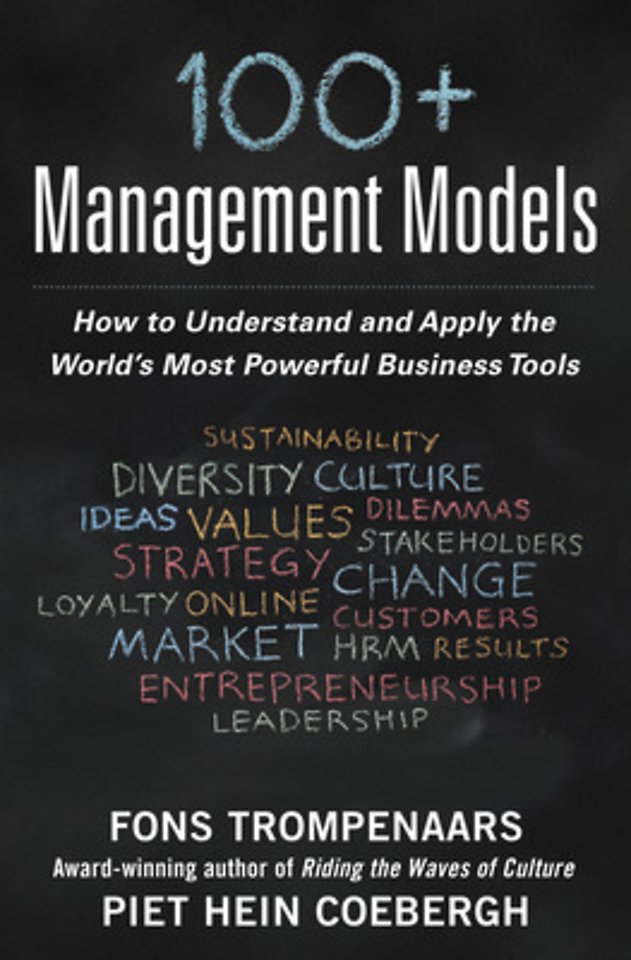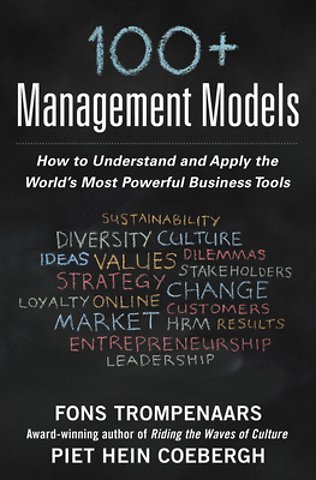Preface xi<br>Introduction 1<br>The Goals of this Book 1<br>Evolution of Management Theories and Models 3<br>Conceptual Models: Handle with Care 11<br>Applying Models in Practice 14<br>Dilemmas 14<br><br><br>PART 1 SUSTAINABILITY 25<br>Model 1 Stakeholder Management, Edward Freeman (1984) 29<br>Model 2 Seven Levels of Sustainability, Richard Barrett (1998) 31<br>Model 3 The Seven Faces of Mount Sustainability, Ray Anderson (1999) 33<br>Model 4 The Bottom of the Pyramid, C.K. Prahalad (2002) 36<br>Model 5 Cradle to Cradle, William McDonough and MichaelBraungart (2002) 38<br>Model 6 The Sustainable Value Framework, Stuart Hart andMark Milstein (2003) 40<br>Model 7 Multiple Stakeholder Sustainability, Fons Trompenaars and Peter Woolliams (2010) 43<br>Reflections on Sustainability 47<br><br><br>PART 2 INNOVATION AND ENTREPRENEURSHIP 73<br>Model 8 Flow, Mihaly Csikszentmihalyi (1975) 77<br>Model 9 Adaption-Innovation Inventory, Michael Kirton (1976) 79<br>Model 10 The Entrepreneurial Process, Jeffry Timmons (1989) 81<br>Model 11 Disruptive Innovation, Clayton Christensen (1995) 84<br>Model 12 Serious Play, Michael Schrage (1999) 86<br>Model 13 Open Innovation, Henry Chesbrough (2003) 88<br>Model 14 Reverse Innovation, Vijay Govindarajan (2009) 91<br>Reflections on Innovation and Entrepreneurship 93<br><br><br>PART 3 STRATEGY AND POSITIONING 123<br>Model 15 Product/Market Growth Matrix, Igor Ansoff (1957) 127<br>Model 16 3C: Company, Customer, Competition, Kenichi Ohmae (1975) 129<br>Model 17 Crafting Strategy, Henry Mintzberg (1978) 132<br>Model 18 Five Forces, Michael Porter (1979) 134<br>Model 19 7S: Tom Peters, Robert Waterman, Julien Phillips (1980) 136<br>Model 20 Core Competencies, Gary Hamel and C.K. Prahalad (1990) 138<br>Model 21 Brand Equity, David Aaker (1991) 141<br>Model 22 Value Discipline, Michael Treacy and Fred Wiersema (1993) 143<br>Model 23 Blue Ocean Strategy, W. Chan Kim and Renée Mauborgne (2005) 145<br>Reflections on Strategy and Positioning 149<br><br><br>PART 4 DIVERSITY OF CULTURES 177<br>Model 24 Myers-Briggs Type Indicator (MBTI), Isabel Briggs Myers and Katharine Cook Briggs (1962) 181<br>Model 25 Corporate Culture, Charles Handy and Roger Harrison (1976) 183<br>Model 26 Hofstede’s Cultural Dimensions, Geert Hofstede (1980) 186<br>Model 27 Belbin’s Team Roles, Meredith Belbin (1981) 188<br>Model 28 Competing Values Framework (CVF), Robert Quinn andKim Cameron (1981) 190<br>Model 29 Three Levels of Culture, Edgar Schein (1985) 193<br>Model 30 Developmental Model of Intercultural Sensitivity (DMIS), Milton Bennett (1986) 195<br>Model 31 Spiral Dynamics, Don Beck and Chris Cowan (1996) 198<br>Model 32 Seven Dimensions of Culture, Fons Trompenaars andCharles Hampden-Turner (1993) 201<br>Model 33 The Colour Theory of Change, Léon de Caluwé andHans Vermaak (2006) 204<br>Reflections on Diversity and Culture 207<br><br><br>PART 5 CUSTOMERS<br>Model 34 Rokeach Value Survey (RVS), Milton Rokeach (1973) 241<br>Model 35 Consumer Behaviour, John Howard and Jagdish Sheth (1969) 243<br>Model 36 3Rs—Retail, Reputation, Relationship, Corstiaan Marinus Storm (1987) 246<br>Model 37 Strategic Purchasing, Peter Kraljic (1983) 248<br>Model 38 Total Perceived Service Quality, Christian Grönroos (1984) 250<br>Model 39 Customer Satisfaction, Noriaki Kano (1984) 252<br>Model 40 Elaboration Likelihood Model (ELM), Richard Petty and John Cacioppo (1986) 254<br>Model 41 Service-Profit Chain, James Heskett, Thomas Jones,Gary Loveman, Earl Sasser and Leonard Schlesinger (1994) 257<br>Model 42 Customer Loyalty, Thomas Jones and Earl Sasser (1995) 259<br>Model 43 Six Stages of Social Business Transformation, Charlene Li and Brian Solis (2013) 261<br>Reflections on Customers 265<br><br><br>PART 6 HUMAN RESOURCE MANAGEMENT 291<br>Model 44 Gainsharing, Joseph Scanlon (1948) 294<br>Model 45 Two-Factor Theory, Frederick Herzberg (1959) 296<br>Model 46 Theory X and Theory Y, Douglas McGregor (1960) 299<br>Model 47 Evolutionary Growth of Organizations, Larry Greiner (1972) 301<br>Model 48 AMO: Abilities, Motivation, Opportunities, Thomas Bailey (1993) 303<br>Model 49 HRM Roles, David Ulrich (1997) 306<br>Model 50 The Happiness Factory, Maurits Bruel and Clemens Colson (1998) 309<br>Model 51 Contextually Based HR Theory, Jaap Paauwe (2004) 311<br>Model 52 Competence-Based Employability, Claudia van der Heijde and Beatrice van der Heijden (2006) 314<br>Reflections on Human Resource Management 317<br><br><br>PART 7 BENCHMARKING AND RESULTS 343<br>Model 53 Management by Objectives, Peter Drucker (1954) 346<br>Model 54 BCG Matrix, Bruce Henderson (1968) 348<br>Model 55 GE-McKinsey Matrix, General Electric and McKinseyConsulting (1971) 350<br>Model 56 The Value Chain, Michael Porter (1985) 352<br>Model 57 Identity and Image, Klaus Birkigt and Marinus Stadler (1986) 354<br>Model 58 Business Process Management (BPM), Michael Hammer (1990) 357<br>Model 59 Balanced Scorecard, Robert Kaplan and David Norton (1992) 359<br>Model 60 Social Media ROI Pyramid, Jeremiah Owyang (2010) 361<br>Reflections on Benchmarking and Results 365<br><br><br>PART 8 LEADERSHIP AND COMMUNICATION 395<br>Model 61 Managerial Grid, Robert Blake and Jane Mouton (1964) 398<br>Model 62 Situational Leadership, Paul Hersey and KennethBlanchard (1969) 401<br>Model 63 Servant Leadership, Robert Greenleaf (1970) 403<br>Model 64 8-Step Change, John Kotter 405<br>Model 65 Situational Crisis Communication Theory, TimothyCoombs (1995) 408<br>Model 66 Level 5 Leadership, Jim Collins (2001) 411<br>Model 67 Cynefin, David Snowden and Mary Boone (2007) 413<br>Model 68 Communication and Employee Engagement, Mary Welch (2011) 416<br>Reflections on Leadership and Communication 419<br><br><br>PART 9 MODELS FOR IMPLEMENTATION 455<br>Model 69 Ethos, Pathos, Logos, Aristotle (350 BC) 458<br>Model 70 AIDA, Elias St. Elmo Lewis (1898) 460<br>Model 71 DuPont Model, Frank Donaldson Brown (1914) 462<br>Model 72 Continuous Improvement, William Edwards Deming (1948) 464<br>Model 73 Brainstorming, Alex Osborn (1953) 466<br>Model 74 Leary’s Rose, Timothy Leary (1957) 468<br>Model 75 Bi-sociation, Arthur Koestler (1964) 470<br>Model 76 Small Group Development, Bruce Tuckman (1965) 472<br>Model 77 360-Degree Feedback, Edward Lawler (1967) 474<br>Model 78 Lateral Thinking, Edward de Bono (1967) 476<br>Model 79 The Conscious Competence Ladder, Lewis Robinson (1974) 478<br>Model 80 FCB Grid, Richard Vaughn (1980) 480<br>Model 81 SWOT, Heinz Weihrich (1982) 482<br>Model 82 Means-End Analysis, Jonathan Gutman (1982) 484Model 83 Learning Style Inventory, David A. Kolb (1984) 486<br>Model 84 Six Principles of Influence, Robert Cialdini (1984) 488<br>Model 85 Scrum, Hirotaka Takeuchi and Ikujiro Nonaka (1986) 490<br>Model 86 The Seven Habits of Highly Effective People, Stephen Covey (1989) 492<br>Model 87 Benchmarking, Robert Camp (1989) 494<br>Model 88 EFQM Excellence Model, The European Foundation for Quality Management (EFQM) (1991) 496<br>Model 89 Strategic Dialogue, Mathieu de Vaan, Steven ten Have and Wouter ten Have (1996) 498<br>Model 90 Strategic Personnel Planning, Gerard Evers and Cornelis Verhoeven (1999) 500<br>Model 91 Mapping, Bridging, Integrating (MBI), Joseph DiStefano and Martha Maznevski (2000) 502<br>Model 92 Yellow Box, Mark Raison (2002) 504<br>Model 93 Elements of Website User Experience, Jesse James Garrett (2002) 506<br>Model 94 MDA Design for “Gamification,” Robin Hunicke, Marc LeBlanc and Robert Zubek (2004) 508<br>Model 95 Business Model Canvas, Alexander Osterwalder (2008) 510<br>Model 96 Sustainability Roadmap, Ram Nidumolu, C.K. Prahalad and M.R. Rangaswami (2009) 512<br>Model 97 Balancing Transparency, Piet Hein Coebergh andEdi Cohen (2009) 514<br>Model 98 Blue Leadership, Jan Moen and Paul Ansems 516<br>Model 99 The Blue Economy, Gunter Pauli (2010) 518<br>Model 100 Eight Routes for Culture Change, Jaap Boonstra (2013) 520<br>Reflections on Models for Implementation 523<br><br><br>Conclusion 525<br>About the Authors 531<br>Our Thanks 532<br>Bibliography 533<br>Sources for the Visualizations of Models 559<br>Index 567<br>

